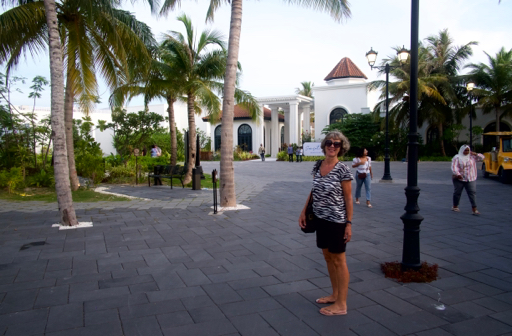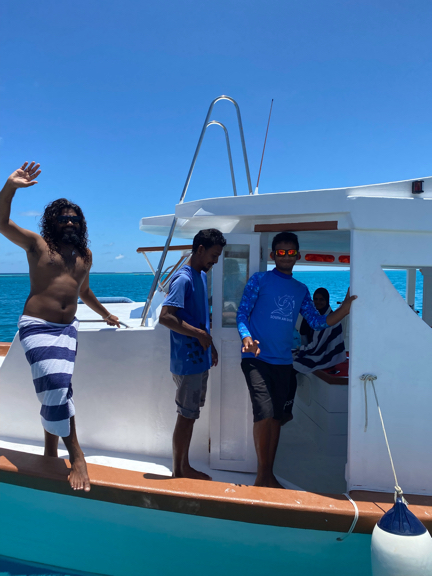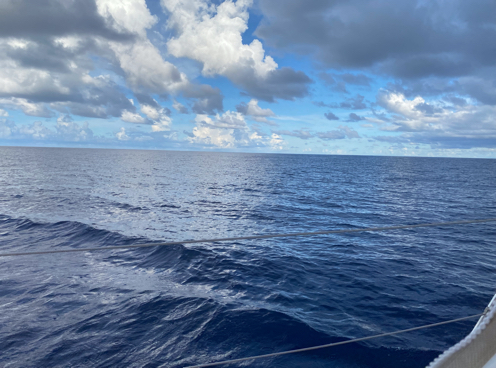Gan

00:41.15S 73:08.66E In the Maldives at this time of year the weather is predictably unpredictable and particularly in the southern atolls. We are in the change from the north east monsoon (dry northerly wind) to the south west monsoon (wet south westerly wind). The wind tends to be light, from the west or south west and atmospheric volatility causes unpredictable low pressure cells leading to very windy squalls. On the way down to Gan we anchored at the island of Veymandhoo. The wind has been blowing mainly from the south west. This has been fine for a course due south or more easterly but on the nose for any course with a westerly component. Heading south you can sail down the middle of the Maldives in between the island chains, through the atolls (in between the islands and isolated reefs and shallow patches) or in the Indian Ocean to the east or west of the island chains. With the prevailing westerly wind there are fewer protected anchorages than in the northern atolls. All this means that passage planning can be a bit of a lottery when the weather is taken into account. We got it right for our overnight sail down to Veymandhoo and had a lovely gentle but fast passage all the way down to the south east corner of the atoll. At this point the forecast westerly wind was firmly in the south west and rose to 15 plus knots despite the forecast of much lighter wind. As a result we had five hours of hard, bumpy motoring into the wind and waves to reach the anchorage. Another yacht sailing to the same place but with an overnight stop chose a westerly route to the south from their anchorage with a south easterly approach across the atoll. They arrived within two hours of us! On the way down we met Jon on Hecla and sailed the last 50 miles together. Endorphin Beta with Colin and Izzi arrived an hour or so after us. Veymandhoo anchorage is considered to be well sheltered which means that, although open to the west wind, it is surrounded by islands and shallow reefs that prevent big waves from building. As the four yachts settled in for the night it clouded over, started to rain and the wind rose. In response we moved Vega further from the Lee shore and re-anchored. Just as well as the wind and rain grew stronger, the wind rising to 30 knots, with thunder and lightning so close you could feel the pressure wave from the thunder. The reason for this weather pattern is usually the arrival north of the equator of the ITCZ (Inter Tropical Convergence Zone, otherwise known as the Doldrums). This belt approximately 300 miles wide around the circumference of the earth is always closest to the sun and from which hot air rises before cooling and sinking to the north and south. Add in the effect of the spinning Earth and you get the formation of the seasonal trade winds. Seasonal because the axis of the spinning Earth is tilted and it takes one year for the tilted Earth to travel around the sun. In the northern summer the northern hemisphere is tilted towards the sun and the southern hemisphere experiences its winter and of course the reverse applies. As a result of this tilt you might also see why the ITCZ moves north and south above and below the equator as the seasons change. At the moment the ITCZ is still south of the equator at the Maldives (in fact it is over Chagos) and so the unpredictable weather is more due to the north east trade wind being cancelled out by south westerly wind resulting from low pressure systems to the south. South easterly wind south of the equator bends to the north west above the equator, causing a south westerly airflow (the direction of wind is expressed as the direction it is flowing from, not towards). So, when planning our passage from the Maldives down to Chagos we have to know what is happening at the moment, how that is affected by the ITCZ and when we are likely to pass through the ITCZ. At this time of year the ITCZ is usually passing over the Maldives and the south east trade wind is establishing over Chagos. in fact quite strong westerly wind is forecast for the Maldives from 1st May - when we are planning to leave. This is due to a deep low pressure system developing in the Bay of Bengal. This might actually be good for us if we can get south quickly enough to avoid the strongest of the wind. However, for just such a scenario we are taking advice from Des Cason, a retired former sailor who can offer weather routing advice for yachts crossing the Indian Ocean. As a South African he is particularly sought after for planning the passage down the notorious Mozambique Channel, where good weather routing is essential. In the meantime we had to get ourselves down to Gan which is a 175nm passage. There are a couple of opportunities to anchor on the way down but we can only enter or leave anchorages in good daylight and this restricts our daytime distances to 50nm at the most. The best anchorage was 100nm so it would still have taken an overnight passage to get to it. That would leave a further 75nm to Gan - another overnight passage. So, a straight two night passage was the quickest way of getting here. The wind was forecast to be light and from the west which would be ideal - providing there was enough to sail without motoring. And also providing it wasn’t more from the SW and stronger than forecast. And that just leaves the squalls. This is the main reason for having radar in the tropics. You can pick up the squalls and assess their size and direction from several miles away and plan a course around or avoiding the middle of them. Sometimes the squalls bubble up and down or laterally and can be impossible to avoid or might just disappear! As it turned out we had a first afternoon of lovely sailing, just as forecast. Then the wind lightened and became very fickle in both direction and strength. With the rolling it was impossible to keep the sails filled and so we had no option but to motor for the best part of 36 hours. On the second afternoon we crossed the equator and shared a can of Singha beer with Neptune. Neptune seemed not to be impressed as we were soon enveloped by coalescing rain squalls from which there was no escape. By sunset the rain was clearing but as we were only 30nm north of Adhoo atoll we had to slow down and so switched the engine off and rolled under bare poles until midnight. At this point our patience with the rolling ran out and we motored on tick-over down to an early morning arrival at Gan. We are about to leave Gan for Chagos on either Saturday or Sunday, depending upon how the customs formalities go. We have a good weather window just ahead of the stronger wind in the Maldives for the 300nm passage. We will spend up to two weeks there and take the first good weather forecast for our onward 10 day passage to the Seychelles, where we plan to arrive before the end of May. We will have no cellnet coverage before the Seychelles so will post a short daily update via the satellites and we can be tracked via our Garmin InReach. We also have our mailasail email for short messages.
|





